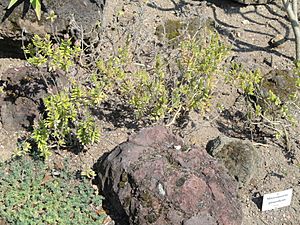Micromeria pineolens facts for kids
Quick facts for kids Micromeria pineolens |
|
|---|---|
 |
|
| Conservation status | |
| Scientific classification | |
| Genus: |
Micromeria
|
| Species: |
pineolens
|
Micromeria pineolens is a special plant found only on Gran Canaria, one of the Canary Islands. People sometimes call it tomillo del pinar or tomillón. This plant is a type of flowering plant that belongs to the Lamiaceae family, which is also known as the mint family. It is currently an endangered species, meaning it is at risk of disappearing forever.
Contents
What is Micromeria pineolens?
Micromeria pineolens is a small, woody plant. It grows like a small bush, usually between 30 and 70 centimeters tall. That's about the height of a school desk! Its leaves are a yellowish-green color and feel a bit hairy. Each leaf is about 1.5 to 2 centimeters long.
Beautiful Pink Flowers
This plant produces pretty pink flowers. These flowers help the plant make seeds and reproduce. They add a lovely splash of color to the dry landscapes where the plant grows.
Where Does It Live?
Micromeria pineolens is native to Gran Canaria. This island is part of the Canary Islands, which are located off the coast of Africa. The plant likes to grow in specific areas, often in pine forests or rocky, sunny spots.
Why Is It Endangered?
Being an endangered species means there are not many Micromeria pineolens plants left in the wild. This can happen for many reasons. Sometimes, it's because their habitat is shrinking due to human activities. Other times, it might be due to climate change or new plants that compete with them. Scientists and conservationists are working to protect this unique plant.
Protecting This Special Plant
Because Micromeria pineolens is endangered, it's very important to protect it. Efforts are being made to save its natural home. People are also trying to grow new plants from seeds to help increase their numbers. Protecting plants like Micromeria pineolens helps keep our planet's biodiversity rich and healthy.
See also
 In Spanish: Tomillo del pinar para niños
In Spanish: Tomillo del pinar para niños


